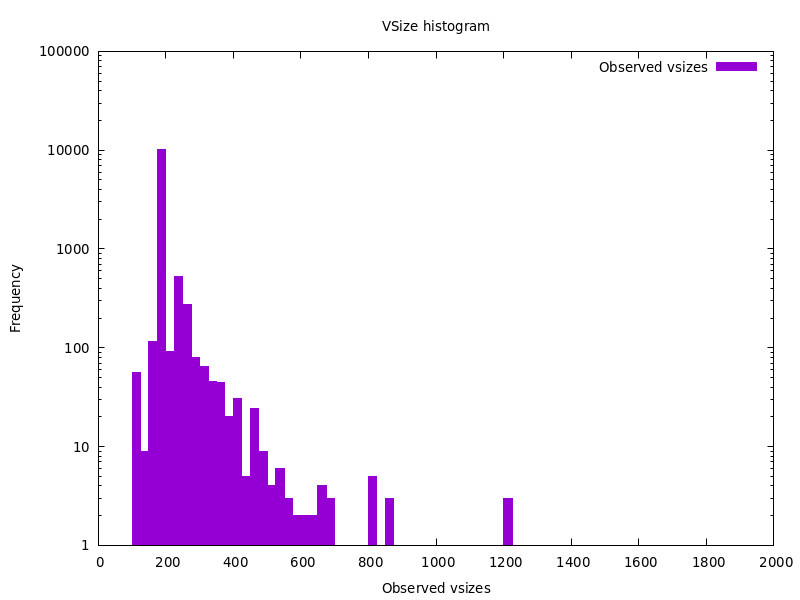Overview
There has been some discussion about taking the v3 policy proposal, which is an opt-in policy for transaction setting nVersion=3, and trying to directly apply it to transactions that appear to be LN commitment transaction spends, based on matching characteristics of such transactions. This would allow the LN project to adopt v3 without making any explicit changes to their software.
This raises questions about what effects such a change would have, so I ran a simulation[1] over all transaction data that I recorded in 2023 to log which transactions would have:
- Matched against our LN commitment template (implemented here), and
- Failed to be accepted to the mempool under the proposed v3 rules (1 parent-1 child, 1000vb max child size, implemented in v3 transaction policy for anti-pinning by glozow · Pull Request #28948 · bitcoin/bitcoin · GitHub).
Results:
- Total transactions that would have been imbued with v3 validation rules: 14124
- Total transactions that would have failed validation using the proposed rules: 856 (6.06%)
Question 1: Is the template matching catching more than just LN commitment transaction anchor spends?
Specifically, are any of the transactions that fail validation likely to be something other than LN anchor spends?
To answer this question, for each of the 856 failed transactions, I ran decodescript on the last stack element in each input’s witness, to see if any of those stack elements appeared to be scripts matching the LN anchor spend template described here.
Of the 856 failed transactions, 173 were never mined [2]; 508 had an input matching that script template, and the remaining 175 had a direct parent which matched the LN anchor spend template. So assuming that script template is uniquely in use by LN implementations, then it would appear no other transactions that would fail these rules would have been picked up by the template.
Question 2: What are the reasons that these transactions are rejected by the v3 validation rules?
- 595 of the transactions failed due to an ancestor count limit being hit (eg batch CPFP or > 1 descendant tx in chain)
- 251 of the transactions failed due to a descendant count limit being hit (multiple anchor spends of the same commitment tx)
- 10 transactions failed due to a size limit being hit. Here are the observed sizes:
0b78e1df093b1f621296d37d26bb8e8ab98d8319e0305cc8df513ca68f840d01 failed (v3 child tx is too big: 1044 > 1000 virtual bytes) 186bbee98e83093a19536d07493cbac81cce7ce04b00bd0ce492c346604baa01 failed (v3 child tx is too big: 1352 > 1000 virtual bytes) 64141aa64f9beb3d67eb9f7b68946cc4aa7b8644faf022ca08c986b9cc004287 failed (v3 child tx is too big: 1304 > 1000 virtual bytes) 709f6bfb9f0522fb2a3543fab6a0b49e4fd8044318e685c2457f7971010628f9 failed (v3 child tx is too big: 1827 > 1000 virtual bytes) 73bae426287150bdc922e9681c81fb8a96b1cc07ebaa97fb60b0fe32849375c4 failed (v3 child tx is too big: 1555 > 1000 virtual bytes) 8effcb0a127a8e1538c7bcb1f4244da5d8eb5943c07cfe91e2a7c0d9c954636d failed (v3 child tx is too big: 1504 > 1000 virtual bytes) 98c5faa56bdafdad6fc568c3be5abeb43b64948539af4c83e6ee75924b44797d failed (v3 child tx is too big: 1216 > 1000 virtual bytes) a936cf2c40af49c10a167e0d6a2b3bf18e256cbd0921d5ca1ca385ade32660ef failed (v3 child tx is too big: 1210 > 1000 virtual bytes) d357ed9634a80320cd68c7dfe46912824cd44328d79f3aae1c12e96c6cf61d56 failed (v3 child tx is too big: 1221 > 1000 virtual bytes) e7f32d8286686443341f93177c67147e5d06df868b11baf7a00034ddd871d981 failed (v3 child tx is too big: 1137 > 1000 virtual bytes)
Question 3: How can we characterize the transactions that fail due to ancestor count limit?
Of the 595 transactions rejected for this reason:
- 99 were never mined.
- 175 of these transactions are because the rejected transaction would have created a length 2 descendant chain, ie the rejected transaction was a spend of an anchor spend.
- 302 appear to be batched CPFP transactions, where multiple anchors are spent in the same tx. I looked at how many inputs matched the anchor spend script template and observed they ranged in size from 2-6 anchor inputs:
Number of anchors spent in a single tx Number of txs 2 252 3 37 4 8 5 3 6 2 Grand total 302
- The remaining 19 transactions had only 1 anchor spend; these transactions appear to have been spending an anchor output as well as the output of some other unconfirmed transaction, though I haven’t exhaustively analyzed these. Here are the txids of the 19 transactions in question:
0f4fb5de29eb33061376eda09d3beab22cf839efb21e5723559bab00f9008ddd 19996cb0fa68f5f712c9c41920ae2bf7c6f643544922a2dd7f0ff631817ab98d 1a098e6320eb9a430906df82356b3a7441874c503284aea1bd91e16c77b35be7 1fdacc8695460ce0177acadb01e80e2dffb80a11e85fae6e3d73b354f02205d3 21daa691908ff940b1e8b6aa71b8452796f39584cc1e3bfe2a746a74907d827e 2d429872c753fa26349d18c6cab25dc19ec7fd6870b51344f07b9bdec72450c2 2e871b6d2a27069cc4ba7ce98cc0858d41444df08bd71622c6c4de92178dedd7 3650677716c8a99ad89cc6f0ffd5a66136f43454458f05f165ba95dcca0ab503 3be9d7f294616fefe213ea50ffcb6d1ad2fbd1aebe127350d96b7f1e34b01b77 4106b6dde4ac651268759c0a52ec23871fa0f2c5dabd368c3119e40566287b62 4e2da138435ca950afa51f684977ac9fe85f10abecb7bd3ae4d9186a0cf3972b 7d4ec17ea3fefbf20d6072a42b4eb1dd65d5a099166f0300c8ea83a8af268a4e 82626a3491d7fb4ce4da7df848205950304d55f5089eedec42142469c2b79a7a 82d1ad4f2657183b1f2caaac5877fcf14b5cdb78d55f89fa9f49910d5061e49b 86d616ae6beb8b28f443bb86a48834f983934dce2574ac5b1a1def0b698e9ddd 8b4a7bab2556389eca15af7aed3260d3f8c5190627ff8a362cde3bd4a379fdc2 917c22ee5b0db446b5d8b9d18974efb0c557b19bd27f89fd9e2a0ea47c19bcb3 c428c5b9baba65e9a8d531abe862b9f5529413af9df879b5d5a660a8c1b8949c d08995dfd33104c153c6f57573dd5d4e66287870641404457eab0e3516b84f0a
Question 4: Across all transactions that matched the template for imbued v3 semantics, what is the distribution of child transaction vsizes?
Here is a histogram I generated of all 14124 transactions (each bin is a range of 25 vbytes). Almost all transactions are small, so this is on a log scale:
The code I ran is here: GitHub - sdaftuar/bitcoin at 2024-01-sim-imbued-v3 ↩︎
I think it’s not a concern if the policy rule would prevent some transactions from being relayed which were never mined anyway, so I have not done any further analysis on these transactions. ↩︎
